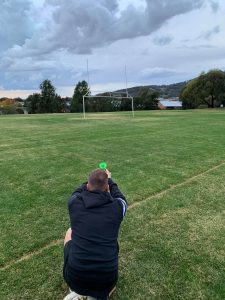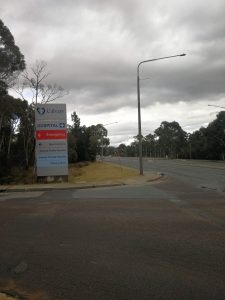Wind-farm protests over the sounds of silence
By BEN MUTANDADZI
GAG orders, infra-soundwaves , mysterious illnesses and space age composites all sound like the makings of a best selling science fiction novel, but this drama is unfolding over wind farms though out Australia.
A recent Federal Senate inquiry, initiated by Family First Senator Steve Fielding, received more than 1000 submissions, both positive and negative, into the possible effects of wind farms on human health and property prices. The Community Affairs References Committee report, The Social and Economic Impact of Rural Wind Farms, recommends that the Federal Government begin to thoroughly investigate these claims.
According to the Clean Energy Council, there are 53 wind farms in Australia, with 1089 turbines that can reach the height of a 45-storey building and have blades up to 50 metres long.
At the heart of the health claims is the presence of infrasound –– low frequency sounds allegedly caused when wind turbines convert wind energy to rotational and acoustic energy. The committee heard claims from property owners living near wind farms that low frequency sounds, normally inaudible to the human ear, were impacting on their quality of life.
The committee heard that people suffering from alleged health problems from infrasound were experiencing the effects of ‘Wind Turbine Syndrome’. The term was first used by American medical practitioner Dr. Nina Pierpont to describe a group of symptoms suffered by people who have lived in close proximity to wind farms. According to Dr. Pierpont, symptoms include “sleep disturbance, headaches, dizziness, vertigo, unsteadiness, tinnitus and high blood pressure.” (Pierpont, 2010)
But British acoustics consultant Dr. Geoff Leventhall disputed this in his statement to the committee.
“The so called ‘Wind Turbine Syndrome’ cannot be distinguished from the stress effects from a persistent and unwanted sound,” Dr Leventhall said. “These are experienced by a small proportion of the population and have been well known for some time.”(Commonwealth, 2011)
Noel Dean, a farmer whose properties are near the Waubra wind farm in Victoria, told the committee that his family was so badly affected by headaches that they were forced to move to Ballarat.
“I tried to stay away from the farm as much as I could, but I had to make a dollar somehow so we went back,” he said. “Every time I went back, if the turbines were going, it would probably take me 10 days to get over it.”
Countries such as Japan and Denmark have been investigating infrasound for years, with Denmark, the so called ‘home of the wind farm’, flagging the need for regulation of infrasound at its wind farms.
A Danish acoustics consultancy firm, Delta, produced a report for the Danish Energy Authority and found that “under steady wind conditions the noise from a wind farm may be exacerbated by a synchrony among noises from more than one turbine. It has been suggested that if the dominant frequencies of different turbines vary by small amounts, an audible beat or dissonance may be heard.” (Minnesota Health, 2009)
However, the deputy director of the Institute of Environmental Studies at the University of NSW, Dr Mark Diesendorf, told the committee that noise from wind farms is rarely an issue beyond 500 metres.
“Noise is rarely a problem beyond a distance of 500 metres and very few dwellings in Australia are within 400 metres of a large wind turbine. Licence conditions for wind farms should, and mostly do, set objective, measurable noise limits.” Dr Diesendorf said. (Commonwealth, 2011)
Infigen Energy spokesperson Richard Farrell believes their wind farms have a proven track record as a safe electricity generating technology.
“Epidemiological studies are usually not undertaken unless there is a compelling body of case studies to identify a problem may exist,” Mr Farrell said, “That evidence has not been found, so Infigen believes that any resources expended would be wasted.”
The Clean Energy Council, made up of over 500 member companies, is a body representing Australia’s alternative energy sector. Clean Energy Council spokesperson Mark Bretherton also welcomed the report.
“We support that if the Government believes this is an important enough issue to sink money into then we aren’t going to be standing in the way of that and it could actually help to cast a bit of light onto this issue and possibly put it to bed,” he said.
Asked about accusations of gag orders on wind turbine property owners, Mr Bretherton denied the existence of such restrictions.
“Certainly we went out to all of our members to get reassurances from them and everyone who is a member of the Clean Energy Council came back and said that they do not advocate or include gag orders in their contracts.”
When travelling along the Federal Highway past Lake George near Bungendore NSW, the wind turbines of the Capital Wind Farm stand out in stark contrast against the natural surrounds of the famous lake and the second major assessment made by the committee addressed the effects of wind farms on property values.
A preliminary assessment report prepared for the NSW Valuer General was referred to in a number of submissions and reached the conclusion that wind farms did not appear to have negatively affected property values in most cases as “no reductions in sale price were evident for rural properties or residential properties located in nearby townships with views of the wind farm”.
Brady’s Country Wide Real Estate has sold many properties in the vicinity of the Capital Wind Farm near Bungendore and owner John Brady believes he has not seen a marked impact on property values.
“Before they were built in this region they definitely had a negative fear factor, a fear of the unknown, but once they were built here, people just took them on their merits,” Mr Brady said. “We recently sold a property on Taylors Creek Road that is about a kilometre from two wind turbines and I had no problem selling that. I’ve spoken to people who have lived in amongst the wind turbines and they don’t seem too bothered.”
While the effects of wind farms on health and property prices is still not truly understood, and the Federal Government is still considering the recommendations of the Senate Committee report, one thing that is certain is that this novel will prove to be a very long read.





Be the first to comment!